Doesn’t time fly? It feels like only yesterday I was being ushered into a darkened booth during a bustling E3 2012 to watch a behind closed doors gameplay demo of the newly-announced MMORPG The Elder Scrolls Online. Here I am now though, some 12 years later, looking at the game again for the game’s 10th anniversary – a milestone that will also be celebrated in-game over the next year, spanning the time between the game’s PC launch in 2014 and the release of its console port in 2015.
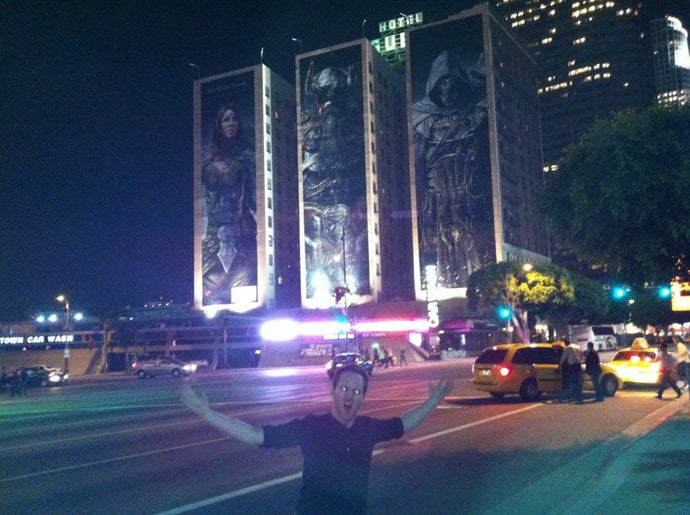
It’s safe to say the The Elder Scrolls Online gameplay I watched at E3 2012 was radically different to what today’s players see, and to be fair, it was radically different to what players saw when the game eventually released two years later, too. Not much, if any, footage still exists of the game as it was then (certainly none with the UI I saw in the demo), but during the early days of development the graphics were simpler and the gameplay was way more reminiscent of classic MMOs of the time, like World of Warcraft and Dark Age of Camelot, featuring on-screen toolbars and a pulled-back third-person camera view with no option for first-person at all.
So why the sudden shift in style so late on in the production process, considering the game had been in development since 2007? By E3 2013, gameplay trailers for The Elder Scrolls Online were showcasing first-person combat and a visual style much more in keeping with the classic single-player Elder Scrolls experiences. I put that question to Matt Firor, president of ZeniMax Online Studios and the man who has been in the driver’s seat for the game since its very inception, and his answer was pretty simple.
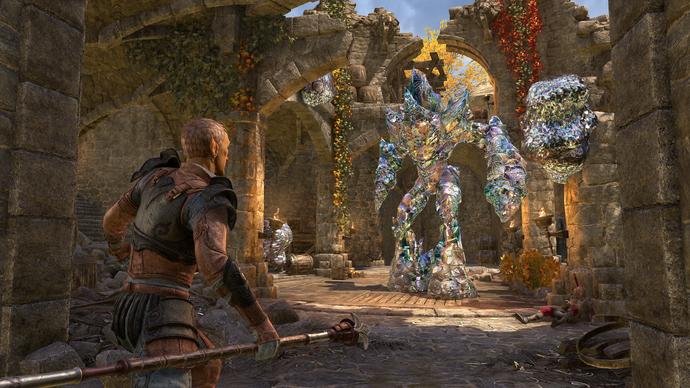
“Skyrim. Skyrim. You’ve got to think back to 2007, right?” Firor says when we catch up at The Elder Scrolls Online’s anniversary event held in Amsterdam this week. “When I founded ZeniMax Online, Oblivion had only launched 18 months before, Fallout 3 hadn’t launched yet and Skyrim was just not even conceived of. It launched, of course, in November 2011 and we had been working on Elder Scrolls Online up until then and you would recognise it, the stories and the quests were all the same, but the wrapper was much more what I call ‘Gen 2 MMO’, where you definitely played the UI more than you played the game.
“After Skyrim came out, it was pretty clear that a ‘Gen 2 MMO’ was not a viable product. Skyrim was so good and it would reach parts of culture that games very rarely reach and so we knew we had to change. And those changes were for the better, because, looking back on it now, all the changes we made were making us more of a virtual world and less of a hallway game where you just went from point A to point B to point C and the game led you around.
“So we did things like first person, but also free combat where you could just shoot an arrow and not have to have anyone targeted, right? That was crazy complicated to do when our base was originally a tab-targeted combat system. But those changes led to a different art style, much more realistic, grittier… much more what you would call The Elder Scrolls today and it also led to fully voiced NPCs and so many other different things.”
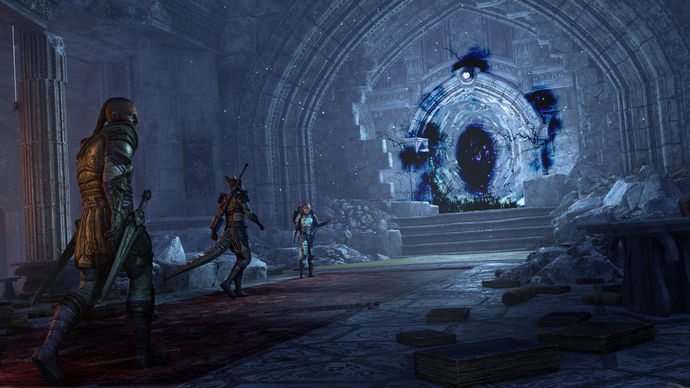
Skyrim was released just two years before ESO’s new visual style was unveiled at E3 2013 via a gameplay trailer that showcased more familiar, fan-pleasing first person-combat. What was it like to remake a game’s core mechanics and visuals? A mix of “sheer terror and great anticipation”, Firor continued.
“We knew we had to do it and we had a limited road because we knew we had to launch the game and the question was, could we do enough of those things in the time that we had by the time we launch? The answer was yes! But then at launch, it was pretty clear we hadn’t done enough of that ‘virtual world-isation’ and the road after that, from PC to console launch and then to One Tamriel was kind of a slow, steady progress towards giving the player more and more freedom in the game.
Indeed, even after that work, I remember being thoroughly underwhelmed by my first play session. Our reviewer at the time, former Eurogamer editor Oli Welsh summed it up best in his Elder Scrolls Online review: “Elder Scrolls fans will be put off by the rigid structure and weak storytelling, while your average MMO player will tire of wading through the wan questing to get to the good stuff,” he wrote. This frosty reception certainly didn’t go unnoticed by Matt and his team.
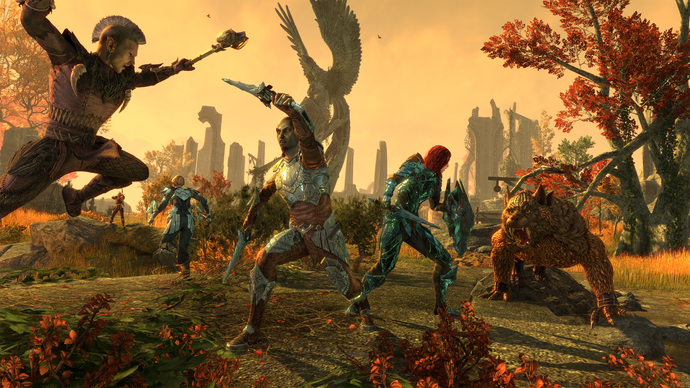
“Obviously with Elder Scrolls and Skyrim, the expectations were off the chart but I think even in the game’s darkest period, which obviously was after PC launch, when we were trying to figure out what to do and sift through all of the feedback, even then we still had a core of players that were playing the game every day for like eight hours. So we knew we had something, and our job then became: ‘look at what those players are doing, and plan to do more of that’.
“We actually went in and played with them. We joined guilds that people were playing a lot and just to kind of see what they were doing. And mostly they were just doing it to be social, have fun, you know, play with their friends, and not take everything so seriously.
“When you design a game like this, you think it’s an Elder Scrolls game, it’s an MMO. But really, it’s a virtual world where people just log into play with each other. And I think that concept, we had it, but it became more and more amplified. And so all the systems we did after that, if you look, were very much to make the game more social over time.”
It wasn’t just Skyrim and social features that pulled The Elder Scrolls Online back from the brink in that troubled period between PC and console launches. Back at E3 2012, the big buzzword being touted by ZeniMax and Bethesda spokespeople was ‘Mega Server’, which was the name of a new piece of server-scaling technology ZeniMax Online had created to ensure that ESO’s servers never had queues and never seemed empty.
“I cannot say strongly enough how much our Mega Server technology helped us weather the storm,” Firor recalls. “Our tech director at the time Amy Dunham, and our lead server architect Ed Dafoe who really was the architect of this system, came up with the genius idea – instead of having shards that were just instances of the game, you instance the zones instead. So instead of, you know, 58 shards, each with a zone, you have one shard with 58 zones. And as people log out of those zones fewer of them populate and as players go into other zones, more of those zone split up.
“If you think about that, at the time, that concept existed, but not in games, and that is of course, cloud technologies. So we wrote a cloud system – our Mega Server system. In the shard world you are screwed, because you could have 50 servers with 10 percent population and you would have to start merging them to get the optimum population. But with Mega Server, you could just spawn fewer zones. And the players in the zones wouldn’t know how many copies of the zones there were. And so while we went through our trough, while we were fixing problems and there weren’t that many players in the game, nobody knew how many players were in the game. We never had to do a server merge, there was no bad PR around that and that’s all because of Mega Server.”
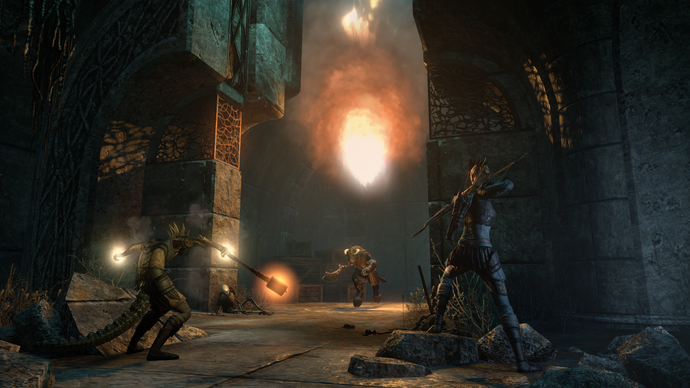
10 years on, The Elder Scrolls Online is still going. And while it may not command many headlines nowadays, it’s still a game with a healthy playerbase thanks to its regular expansions and updates. Could things have gone smoother at launch if some of the game’s more recent features had been present then? Sure, Firor says, though hindsight is a wonderful thing.
“Obviously, having level scaling in from the beginning would have made ESO even more successful,” Firor says. “That’s the obvious big one. Housing! We don’t talk about housing enough, because why do you talk about housing with the media about a game like this? But we have people that play ESO and just do housing and it is not a small amount of people.
“You can set your house to home decorator privilege, which means you can invite someone into your house, and they can decorate your house for you. We have a community of people that do nothing but get paid in-game money to go decorate people’s houses. There’s a meme in the ESO community that housing is the true endgame! And it is if you go out and look at YouTube and Twitch channels of the stuff people build, it’s unbelievable.”
So what’s next? With The Elder Scrolls 6 on the horizon for Bethesda but still a few years off, how with The Elder Scrolls Online keep fans of the franchise sated? “I’m not even going to speculate,” Firor says when I namedrop the upcoming game. “Everyone wants their Elder Scrolls 6 headline!”
And yet perhaps right now should be The Elder Scrolls Online’s time. For a game that underwent massive changes shortly before launch and then almost failed at the first hurdle, it’s great to see the MMO managing to make it to a decade – and beyond, with the release of its upcoming Gold Road expansion in June, which features a return to Southeast Cyrodiil, a part of Tamriel that players may remember from 2006’s Oblivion. It seems likely the game has a few years’ left in it yet.
- SEO Powered Content & PR Distribution. Get Amplified Today.
- PlatoData.Network Vertical Generative Ai. Empower Yourself. Access Here.
- PlatoAiStream. Web3 Intelligence. Knowledge Amplified. Access Here.
- PlatoESG. Carbon, CleanTech, Energy, Environment, Solar, Waste Management. Access Here.
- PlatoHealth. Biotech and Clinical Trials Intelligence. Access Here.
- Source: https://www.eurogamer.net/how-the-success-of-skyrim-changed-the-elder-scrolls-online?utm_source=feed&utm_medium=rss&utm_campaign=feed
- 10
- 10th
- 12
- 2006
- 2012
- 2013
- 2014
- 2015
- 50
- 58
- 690
- a
- About
- actually
- after
- again
- age
- All
- almost
- also
- am
- amount
- Amplified
- amsterdam
- amy
- an
- and
- Anniversary
- answer
- anticipation
- any
- anyone
- ARE
- around
- Arrow
- Art
- artwork
- as
- At
- average
- awesome
- back
- bad
- base
- BE
- became
- because
- been
- before
- beginning
- behind
- being
- BEST
- Bethesda
- Better
- between
- beyond
- BIG
- brink
- build
- bustling
- but
- button
- buzzword
- by
- C
- call
- came
- Camelot
- camera
- CAN
- Catch
- celebrated
- certainly
- change
- changed
- changes
- channels
- chart
- Classic
- clear
- closed
- Cloud
- combat
- community
- complicated
- conceived
- concept
- considering
- Console
- Console Port
- continued
- copies
- Core
- could
- course
- crazy
- created
- Culture
- Dark
- day
- days
- decade
- definitely
- Demo
- Design
- Development
- DID
- didn
- different
- Director
- do
- doing
- don
- done
- doors
- driver
- During
- e3
- each
- Early
- editor
- eight
- enough
- ensure
- Eurogamer
- even
- Event
- eventually
- Every
- everyone
- everything
- existed
- exists
- expansion
- expectations
- Experiences
- Failed
- fair
- fallout
- Fallout 3
- familiar
- fans
- Features
- featuring
- feedback
- feels
- few
- fewer
- Figure
- First
- Fly
- For
- Former
- founded
- Franchise
- Free
- Freedom
- Friends
- from
- front
- fully
- fun
- game
- gameplay
- Gameplay Trailer
- Games
- Gaming
- genius
- Get
- Giving
- go
- going
- Gold
- gone
- good
- got
- graphics
- great
- guilds
- had
- has
- Have
- having
- he
- Headlines
- healthy
- held
- helped
- here
- Hindsight
- his
- Home
- horizon
- hotel
- hours
- House
- houses
- housing
- How
- HTTPS
- hurdle
- i
- idea
- if
- in
- in-game
- inception
- instance
- instead
- into
- invite
- Is
- IT
- ITS
- Job
- joined
- jpg
- june
- just
- keep
- keeping
- kind
- know
- large
- late
- later
- launch
- launched
- launches
- lead
- Led
- left
- less
- Level
- like
- likely
- Limited
- log
- Look
- looking
- looking back
- lot
- made
- make
- Making
- man
- managing
- many
- massive
- matt
- May
- means
- Mechanics
- Media
- meme
- Merge
- merging
- milestone
- mix
- MMO
- MMORPG
- money
- months
- more
- mostly
- much
- my
- name
- never
- New
- Next
- no
- None
- not
- nothing
- November
- now
- obvious.
- Obviously
- of
- off
- on
- One
- online
- only
- Option
- originally
- Other
- our
- out
- over
- paid
- part
- parts
- PC
- People
- percent
- perhaps
- period
- person
- piece
- plan
- plato
- plato data intelligence
- platodata
- platogaming
- play
- played
- player
- players
- Playing
- Point
- population
- posing
- pr
- present
- president
- pretty
- pretty simple
- privilege
- problems
- Process
- Product
- Production
- Progress
- put
- question
- quests
- Radically
- rarely
- reach
- realistic
- really
- recent
- reception
- recognise
- regular
- release
- released
- Remake
- Remember
- reminiscent
- return
- right
- rigid
- road
- s
- safe
- same
- saw
- say
- says
- scaling
- SEAT
- see
- seemed
- seems
- seriously
- server
- servers
- session
- set
- shift
- shortly
- should
- showcased
- showcasing
- Simple
- simpler
- since
- single-player
- Skyrim
- slow
- small
- smoother
- So
- Social
- some
- someone
- something
- southeast
- spanning
- Spawn
- split
- start
- steady
- still
- Stories
- Storm
- storytelling
- strongly
- structure
- style
- success
- successful
- sudden
- sure
- system
- Systems
- Take
- talk
- targeted
- Team
- tech
- Technologies
- Technology
- than
- thanks
- that
- The
- The Elder Scrolls
- The Elder Scrolls 6
- The Elder Scrolls Online
- The Game
- the wrapper
- their
- Them
- then
- there
- they
- thing
- things
- think
- this
- those
- though
- Through
- time
- to
- Today
- too
- towards
- trailer
- Trailers
- true
- trying
- Twitch
- two
- ui
- underwent
- until
- unveiled
- up
- upcoming
- Updates
- us
- ushered
- ve
- very
- via
- viable
- Video
- View
- Virtual
- virtual world
- visual
- visual style
- visuals
- wants
- Warcraft
- was
- wasn
- Watch
- way
- we
- weather
- week
- went
- were
- weren
- What
- when
- where
- while
- WHO
- why
- will
- with
- Work
- working
- world
- World of Warcraft
- would
- wouldn
- wrote
- year
- years
- yesterday
- yet
- you
- young
- your
- youtube
- Zenimax
- zephyrnet
- zone











